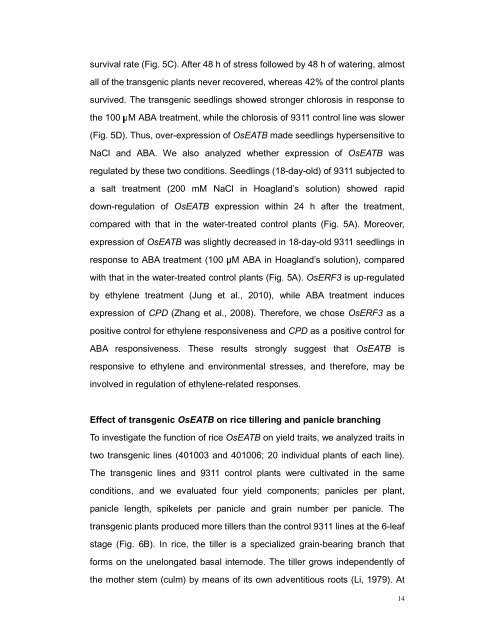Rice ERF OsEATB restricts GA biosynthesis - Plant Physiology
Rice ERF OsEATB restricts GA biosynthesis - Plant Physiology
Rice ERF OsEATB restricts GA biosynthesis - Plant Physiology
You also want an ePaper? Increase the reach of your titles
YUMPU automatically turns print PDFs into web optimized ePapers that Google loves.
survival rate (Fig. 5C). After 48 h of stress followed by 48 h of watering, almost<br />
all of the transgenic plants never recovered, whereas 42% of the control plants<br />
survived. The transgenic seedlings showed stronger chlorosis in response to<br />
the 100 μM ABA treatment, while the chlorosis of 9311 control line was slower<br />
(Fig. 5D). Thus, over-expression of <strong>OsEATB</strong> made seedlings hypersensitive to<br />
NaCl and ABA. We also analyzed whether expression of <strong>OsEATB</strong> was<br />
regulated by these two conditions. Seedlings (18-day-old) of 9311 subjected to<br />
a salt treatment (200 mM NaCl in Hoagland’s solution) showed rapid<br />
down-regulation of <strong>OsEATB</strong> expression within 24 h after the treatment,<br />
compared with that in the water-treated control plants (Fig. 5A). Moreover,<br />
expression of <strong>OsEATB</strong> was slightly decreased in 18-day-old 9311 seedlings in<br />
response to ABA treatment (100 μM ABA in Hoagland’s solution), compared<br />
with that in the water-treated control plants (Fig. 5A). Os<strong>ERF</strong>3 is up-regulated<br />
by ethylene treatment (Jung et al., 2010), while ABA treatment induces<br />
expression of CPD (Zhang et al., 2008). Therefore, we chose Os<strong>ERF</strong>3 as a<br />
positive control for ethylene responsiveness and CPD as a positive control for<br />
ABA responsiveness. These results strongly suggest that <strong>OsEATB</strong> is<br />
responsive to ethylene and environmental stresses, and therefore, may be<br />
involved in regulation of ethylene-related responses.<br />
Effect of transgenic <strong>OsEATB</strong> on rice tillering and panicle branching<br />
To investigate the function of rice <strong>OsEATB</strong> on yield traits, we analyzed traits in<br />
two transgenic lines (401003 and 401006; 20 individual plants of each line).<br />
The transgenic lines and 9311 control plants were cultivated in the same<br />
conditions, and we evaluated four yield components; panicles per plant,<br />
panicle length, spikelets per panicle and grain number per panicle. The<br />
transgenic plants produced more tillers than the control 9311 lines at the 6-leaf<br />
stage (Fig. 6B). In rice, the tiller is a specialized grain-bearing branch that<br />
forms on the unelongated basal internode. The tiller grows independently of<br />
the mother stem (culm) by means of its own adventitious roots (Li, 1979). At<br />
14

















